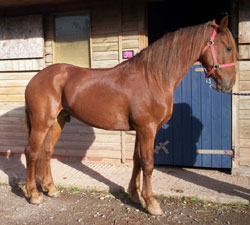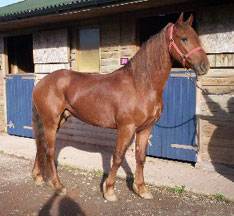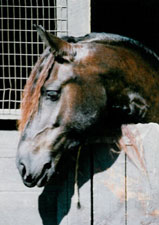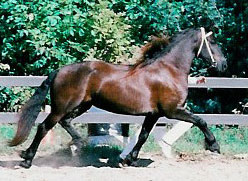Care & Health
Grooming
- Scratches
- Sun-Bleaching
Joint Issues
- Locking Stifles
- OCD
Genetics
- Chestnut Factor
- Dwarfism
Reference
History of the Friesian
Encyclopedia
Care & Health
Historic Notes
Useful Dutch Words
Approved Stallions
Friesian Fanatics
Friesian Forum
Friesian Tales
Product Reviews
Friesian Classifieds
Directories
Friesians are wonderful horses, but as much as we may wish it, no horse is perfect and there are invariably certain ailments that predispose themselves to certain types and breeds. This page will attempt to outline some of the ailments that have been known to affect Friesian horses. The information on these pages has been gathered from as reputable sources as possible, but the accuracy of these articles cannot be guaranteed and any medical concerns about your horse should always be posed to your veterinarian. To contribute ideas or content to this page or report some error you've spotted, please e-mail friesiancrazy@gmail.com.
 The chestnut factor refers to the occasional birth of chestnut Friesian foals (also referred to in recent years as fox friesians). The Friesian breed has traditionally been black in coloration, and this has become the breed standard, so deviations from the standard, such as chestnut coloration is for the most part undesirable among breeders. The early Friesian horses had coat colors of all varieties, but since then these variations have been selectively bred out in favor of black. However, the chestnut gene is what is called 'recessive' meaning that it tags along with the black color gene, but doesn't show itself. We'll call the chestnut gene (c), small letter because it is recessive, and the black gene (B), large letter because it it dominant.
The chestnut factor refers to the occasional birth of chestnut Friesian foals (also referred to in recent years as fox friesians). The Friesian breed has traditionally been black in coloration, and this has become the breed standard, so deviations from the standard, such as chestnut coloration is for the most part undesirable among breeders. The early Friesian horses had coat colors of all varieties, but since then these variations have been selectively bred out in favor of black. However, the chestnut gene is what is called 'recessive' meaning that it tags along with the black color gene, but doesn't show itself. We'll call the chestnut gene (c), small letter because it is recessive, and the black gene (B), large letter because it it dominant.
So black horses whose dominant color gene is black, but who carry a recessive chestnut gene (Bc) may, when bred to another black horse who carries a recessive chestnut gene (Bc), produce a chestnut foal (cc). In order for a chestnut foal to be produced both parents have to be Bc, and the odds have to be in their favor, for even in this situation, the black gene is still dominant, allowing only a 25% chance of producing a pure chestnut foal (cc).
If a horse carrying a chestnut gene (Bc) is bred to another who does not carry it (BB), the resulting foal has no chance of being chestnut. Obviously the same is true if both parents are (BB), in which case they really will be a true black.
 So? Well, because many horses carry the chestnut gene and it cannot be completely eradicated, the FPS registry has tested all it's approved stallions for the gene so that mare owners can make informed decisions when breeding. The registry has also begun testing young stallions for the chestnut gene and pulling them from the approval process if they are carriers to reduce future incidences of chestnut foals. So a mare owner today can test their own horse to see if she carries the gene, then, if she does, then choose a stallion who is not a carrier, thus ensuring a black foal. Although the occurrence of chestnut foals is in no way a very serious breeding or health issue, since no actual physical harm comes to the foals and the only objection is cosmetic, it is however, something to be aware of for those in the FPS registry when choosing stallions for certain mares.
So? Well, because many horses carry the chestnut gene and it cannot be completely eradicated, the FPS registry has tested all it's approved stallions for the gene so that mare owners can make informed decisions when breeding. The registry has also begun testing young stallions for the chestnut gene and pulling them from the approval process if they are carriers to reduce future incidences of chestnut foals. So a mare owner today can test their own horse to see if she carries the gene, then, if she does, then choose a stallion who is not a carrier, thus ensuring a black foal. Although the occurrence of chestnut foals is in no way a very serious breeding or health issue, since no actual physical harm comes to the foals and the only objection is cosmetic, it is however, something to be aware of for those in the FPS registry when choosing stallions for certain mares.
The horse pictured is a chestnut Friesian gelding owned by Adel Phillips. For more photos of chestnut Friesians, try visiting this website.
Suggested Reading:
[The More Detailed Look at the Chestnut Factor] - An article by Dr. Geurts, reprinted from International Phryso, published in "The Friesian" July/August 2003 edition.
[Equine Color: Chestnut] - A non-profit website which offers basic information on color genetics, including an example of a chestnut Friesian.
Dwarfism, while certainly not to be described as common in the Friesian breed, is somewhat present. The condition itself is most commonly associated with miniature horses, but does occur more rarely in the larger breeds.
There are two types of dwarfism: achondrodystrophic, which is generally a normally proportioned body with extremely short legs and ears; and brachiocephalic, which is more visually extreme, commonly with disproportionate heads, and disfigured legs, spines and jaws. Both types of dwarfism are debilitating, though the severity may range depending upon the individual.
Suggested Reading:
[Dwarfism in the Friesian and Warmblood Friesian Horse] - An article compiled by the Australian Warmblood Friesian Association. Includes reports by the FPS and Dutch veterinarians addressing the issue of dwarfism in the Friesian breed.
Personal Account
 I was blessed with a surprise birth of a friesian filly. She had several medical issues and multiple vet assessments. It was suggested that one of her "issues" was dwarfism. Please see my web site for her story, she is Tifrons. I would be happy to send you more pictures if you are interested. www.dragonflyacres.ca
" -- Lisa [lisa@dragonflyacres.ca]
I was blessed with a surprise birth of a friesian filly. She had several medical issues and multiple vet assessments. It was suggested that one of her "issues" was dwarfism. Please see my web site for her story, she is Tifrons. I would be happy to send you more pictures if you are interested. www.dragonflyacres.ca
" -- Lisa [lisa@dragonflyacres.ca]
OCD is a degenerative joint disease ( a type of developmental orthopaedic disease or DOD) usually found in young, rapidly growing horses who will eventually mature to over 15 hands. As may be expected, Friesians can be prone to the disease, simply due to their size. OCD occurs when cartilage at the end of growing bones, instead of hardening into bone, begins to break down. As a result of this break-down, small bits of cartilage may break completely or partially off and harden into bone cysts, which irritate the area of the joint, causing a build up of fluid (swelling), and pain (lameness).
OCD can be identified by lameness or swelling commonly in the hocks, stifles and fetlocks of young horses, especially those who have recently entered training or become more active, putting more stress on their growing joints. OCD can also cause locking stifles. Although OCD is commonly identified by a lameness, in some cases there may be no obvious symptoms, in which case the problem will likely clear up on it's own. The cause of OCD has been linked to nutrition, particularly mineral imbalances, as well as trauma from excessive physical exercise. The disease is also thought to be at least somewhat genetically inheritable.
OCD can be officially diagnosed by x-rays and other veterinary procedures. Once determined that a lameness is in fact caused by OCD, traditional treatment options include joint injections, stall rest and a change in diet, or surgery to remove the floating bone fragments from the joint. Left untreated, OCD can cause significant, long-term joint damage, and the fullness of recovery after treatment varies depending upon the individual.
Suggested Reading:
[Liphook Equine Hospital: Osteochondritis Dissecans (OCD)] - An informative article on OCD, it's causes, treatment and prevention.
Also known as pastern dermatitis and grease heel, scratches is a skin irritation commonly associated with draft horses and other breeds with long feathers, though it may also occur in those with very little fetlock hair as well. It occurs most commonly as scabs on the back of the pastern and fetlock joints, and occasionally up the legs on the hocks or knees. These scabs may be sensitive if picked at, and depending upon the severity, may break open and ooze serum and blood. These scabs and open sores can be painful and some horses may go lame with serious cases, as well as show heightened sensitivity around the area(ie: watch out when picking hooves and bending the afflicted area). Although not a rule, it often is worse in those horses with very thick fetlock hair. Signs that a horse may have scratches include itching the afflicted area with the teeth, or with a hoof (often you will see them rubbing one back leg against the other).
In Friesians it is acknowledged as a common complaint and most will likely contract it at some point, though it occurs in varying severity depending upon the individual. The actual cause of scratches isn't known with any real certainty, though there are varying theories, and the most likely explanation is that there are multiple causes for variations of the affliction. Many believe it is associated with a wet and unclean turnout or stall area where the horse must stand in unclean mud or muck for a long period. It may also be caused by mites or bacteria.
Just as there are many theories to it's cause, there are many theories on how to clear up a break-out of scratches. If scratches is a chronic occurrence and needs treatment regularly, it is often recommended to shave the back side of the pastern to allow the area exposure to air and easy treatment. (Don't worry..if the horse has thick enough hair, this can be done without shaving off those trademark feathers. Shave only the center of the pastern where the scratches occur and leave hair on the sides to cover the patch.)
Suggested Reading:
[Pastern Dermatitis by Joca van der Veen, DVM] - An article written for the North American Friesian Horse Journal by a Dutch vet on the issue of scratches in the Friesian breed.
Have a great scratches treatment? Share it with the rest of us.
"My FSH hasn't had scrathes (thank goodness!) but my TB got scratches a couple years ago. I tried everything! And the best remedy for me was to GENTLEY wash his legs with Anti-Bacterial dish soap. Let them dry and then apply Panalog (topical ointment, usually used on dogs) then apply a clean bandage. And it heals in no time at all. Really wish I had known that combo a lot sooner! I really did try everything out there! Store bought and home remedy. My vet said like Parvo (in dogs) the bacteria can live on the ground or other areas of contact. So if you are at a boarding facility (I was at that time) so be sure to check daily and attack it at the first signs of out break!" -- Mishka[mln1977@myway.com]
"Hi,I've owned my Friesan gelding for over 9 years and found our best solution for scratches is to wash the legs especially heals and feathers in an anti-bacterial wash like hibiscrub then thoroughly dry the area. I managed to buy FrontLine Flea spray from my vets that you use for cats and dogs, and applied this to his clean legs. This I do around 3 or 4 times a year and has helped extremely. The treatment was recommended by my farrier who has other owners with Friesians." " -- Patricia [emnm775@hotmail.com]
"The friesian I ride gets scratches on a semi-regular basis (mostly in the summer with increased sweating & bathing). The best solution I've found so far is to keep antibacterial mouthwash (like Listerine) on hand and a tube of diaper rash ointment (or any other zinc oxide cream). As a solution, often just dousing the scratches with the Listerine once or twice a day will clear it up, and as prevention in the summer I douse all the feathers right after bathing & let it dry before I put him back in his stall. Also, if one does get bad to the point that it's opened up a bit, the zinc oxide can help dry it up and help it heal (though it's gets a little messy in the feathers, so only a minimal amount is necessary). But I usually use the listerine once per day, and the zinc oxide later in the day if using it as a cure. Good luck! " -- Alisa [alisarose@gmail.com]
"Hi, My name is Jeanine and I have a friesian cross...Not until this year did we experience itching, he will be 5 years old in the spring. I thought it was the no-seeums, as we have had a ton of rain this year in NW Ohio, and you can see the gnats when the sun is setting, he itches thru the chest, legs, I have tried everything including a steriod paste from the vet, didn't seem to work, he does seem to be clearing up, but it's hard to give baths this time of year, and then the bugs are drawn to wet bodies... Any other ideas for my buddy, Bravo, he sure could use some guidance. Thanks for trying to help." -- Jeanine [friesianheaven@udata.com]
"I was given this advice from an "Old-timer" Draft horse breeder: To cure outbreaks of Scratches, simply wet a sponge and apply Phels Nafta Soap till sudsy. Then lightly apply to the affected areas." -- Lynn
"When I got Apollo he had terrible scratches. The vet said the only way to cure it was to shave his feathers. Well, that's why I got a Friesian! A friend said that at her barn all the horses (not Friesians) are treated once a week to prevent scratches. They use Dawn anti-bacterial dish soap and a brush and put the soap on the brush and with the feet wet, scrub each leg. So for about a week I used Dawn on his feet each day and it cleared up! On the one leg that was really bad with oozing, I didn't use a brush because I didn't want to hurt him. Also, you can spread it (I read) from one foot to the other, so I did the worse area last, then bleached the brush for the first couple days. It's been 1 1/2 years and it has never come back!" -- Cynthia [curlywillowranch@comcast.net]
"The product I have found to be excellent for rain rot, scratches, etc. is EQyss Micro Tek. Two or three treatments, and you can see a difference. I've never used it on my Friesian, but my trainer said she used it on a horse she tried everything on,for scratches, and it's the only thing that worked. My Walker had rain rot, and it cleared it up quickly. Good on other skin problems, also." -- Jeanne Belcher [itz2spirithorses@aol.com]
Locking stifles or the upward fixation of the patella is often seen in the Friesian breed, sometimes simply as a short term problem in young growing horses, and sometimes as a chronic problem, especially in horses whose hind legs are very straight and stifles upright. The stifle joint itself is a very complicated body part, the equine equivalent of the human knee. The patella is in effect, the horse's knee cap, but unlike people, horses have the ability to physically lock (fixate) their leg in the extended position by slipping the space between their ligaments over a protrusion in the bone (obviously this is a very simplified explanation). This purposeful locking of the stifle allows the horse to remain upright while sleeping or resting without falling over.
The problem occurs when in some horses, the stifle will shift into it's 'locked' mode during normal movement, or will lock normally at rest but will be difficult for the horse to 'unlock' in order to move. The severity ranges dramatically, from a slight 'hitching' of the joint as the horse tries to keep it from catching, to a complete lock of the joint, so that the horse is unable to bend it whatsoever and must swing the limb out to the side by the hip in order to move and until the joint frees itself.
The classic symptom of a locked stifle is apparent when a horse moves off from a stand still and the effected hind leg jerks suddenly upward. It should also be mentioned that when a horse with locking stifles has been standing in the cross-ties and a groom attempts to pick up the hoof of the effected leg, if the joint is locked, the horse will as described, jerk his leg up suddenly as the joint frees itself. This can pose some risk to the groom, but is often misconstrued as the horse purposefully kicking out at it's handler, when it may in fact be simply the reaction of the joint.
There are varying degrees of treatment for locking stifles. The most common is a set exercise regimen aimed at strengthening the stifles and hind legs, such as working on a hill or incline and working in deep sand. Other treatments include corrective shoeing, 'blistering', and hormone therapy. Surgery is available but is unreversable and may cause other problems in the joint, and so should be considered as a last resort.
A temporary solution for a horse who is 'stuck' and cannot step forward because of the locked joint, is to back the horse one or two steps, then step forward, as this usually frees the stifle.
Suggested Reading:
[AEC Client Education: Upward Patellar Fixation] - An in-depth, but easy to read article by the Atlanta Equine Clinic, describing the causes, symptoms and common treatments of locking stifles. Reccomended for those researching the problem.
[FriesianExchange.com: Stifle Question] - An answer to a submitted question to FriesianExchange.com about locking stifles, written by Jan Glas, and Harry Voesten, MD.
 All Friesians (excepting the rare chestnut) are black, a commonly known fact. But not all blacks are created equal. Friesians actually come in a variety of shades of black, ranging from true blue-black to essentially a very dark black brown or bay. In the winter, this is likely unnoticable, but in the summer, when the long hair is shed and the sun comes out, your previously dark black Friesian may end up turning a startlingly lighter shade. Depending upon the individual horse, this may be due to just the basic coat color, or it may be due to prolonged exposure to the sun, or both. Normally sun bleaching is caused by a combination of an inherently brown-tinged coat with salty sweat and the summer sun. On some horses sun-bleaching effects mostly the mane, forelock and tail, turning the tips of the hairs a sometimes startlingly bright red-orange or brown. In other cases, the entire body area of the horse (not the legs, or ears) begins to lighten to an almost dark gold-brown color.
All Friesians (excepting the rare chestnut) are black, a commonly known fact. But not all blacks are created equal. Friesians actually come in a variety of shades of black, ranging from true blue-black to essentially a very dark black brown or bay. In the winter, this is likely unnoticable, but in the summer, when the long hair is shed and the sun comes out, your previously dark black Friesian may end up turning a startlingly lighter shade. Depending upon the individual horse, this may be due to just the basic coat color, or it may be due to prolonged exposure to the sun, or both. Normally sun bleaching is caused by a combination of an inherently brown-tinged coat with salty sweat and the summer sun. On some horses sun-bleaching effects mostly the mane, forelock and tail, turning the tips of the hairs a sometimes startlingly bright red-orange or brown. In other cases, the entire body area of the horse (not the legs, or ears) begins to lighten to an almost dark gold-brown color.
 Preventative measures can be taken to keep the coat color dark during the summer, the most effective of which may be to keep the horses inside during the daytime and put them out at night. This also allows the dark-colored Friesians to stay inside in the shade during the heat of the day which may help to keep them from overheating in the high temperatures of summer. Some people put sheets on their Friesians, though this does not protect the head or neck from the sun. There also exist some feed supplements such as Black-as-Knight which claim to darken the coat, though results vary.
Preventative measures can be taken to keep the coat color dark during the summer, the most effective of which may be to keep the horses inside during the daytime and put them out at night. This also allows the dark-colored Friesians to stay inside in the shade during the heat of the day which may help to keep them from overheating in the high temperatures of summer. Some people put sheets on their Friesians, though this does not protect the head or neck from the sun. There also exist some feed supplements such as Black-as-Knight which claim to darken the coat, though results vary.
That said, there is nothing physically wrong with a light-coated Friesian, and they are not penalized at the Inspections for it, so many people are rightfully quite content to leave their horses their natural shade of (light) black.
Comments:
"I live in Tenerife so my friesian is exposed to a lot of sun. She is jet black in winter and a burned black in summer. The solution is uv hair protector for humans. Sprayed on the coat once or twice a day works a treat." " -- Susan [sue1_ellis@yahoo.co.uk]
"I'm looking for horses that test "black" (E_, aa) yet looked brownish at birth and continually, throughout their lives, including newly growing-in coats. Not sun bleaching. Most commonly called "light black". If you have one, or know of one, please contact me. (I'm a horse color researcher.)" -- Barbara Kostelnik [bak@one.net]
Do you have a great treatment for scratches? Have experience with a certain Friesian health issue? If you have information and advice you want to share, either e-mail me at friesiancrazy@gmail.com or use the easy form below.
Friesian Health Survey
Read the results of the Friesian Health Survey (PDF file).
Wanted
Articles, photos, information, opinions, or professional input on these Friesian health topics:
- EPSM
- Retained Placentas
- Scratches photos
- Braiding Techniques
- Cryptorchidism
- Dwarf Friesian photos
- Fox Friesian photos



